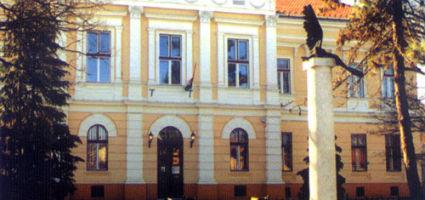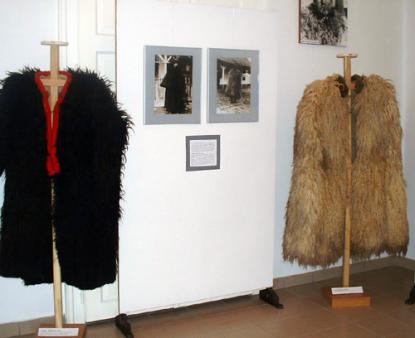2025. May 11. Sunday
Bihar Museum - Berettyóújfalu
 |
Address: 4100, Berettyóújfalu Kálvin tér 1.
Phone number: (54) 402-390, (54) 500-340
E-mail: bihari.muzeum@gmail.com
Opening hours: Mon-Fri- 10-16
|
The exhibition has closed for visitors.
2003.05.22. - 2004.01.30.
Museum tickets, service costs:
|
Ticket for adults
|
500 HUF
|
|
|
Ticket for students
(6-26 years of age)
|
250 HUF
|
|
|
Ticket for pensioners
(62-70 years of age)
|
250 HUF
|
|
|
Group guide
(up to 25 people)
|
1000 HUF
|
/ group
|
|
Photography
|
500 HUF
|
|
|
Video
|
500 HUF
|
In Berettyóújfalu the small fur coat was called "túri coat". It was in fashion up to the first world war, but it faded by the middle of the century. It was not cheap, however, it was a generally warn attire.
 It was put together of several pieces of leather. The coat was made up by 2 pieces in the front, 2 sides and 1 back.
It was put together of several pieces of leather. The coat was made up by 2 pieces in the front, 2 sides and 1 back.
The big coat was made of sheep skin. It was white with black collar around the neck. Only the most opulent ones could afford purchasing it.
It had two basic types: the ornamented and the normal ones. The shoulder of the ornamented one was embroidered. Its collar was made of black lamb skin. In dry weather they wore it with skin outward, in wet vice versa. Up to the 19th century they had been embroidered by twisted silk, later tinted wool was used.
The "guba" is one of the most simple and oldest attires. It was used in winter time, made out of sheep skin. It was warm, protecting from the rain as well. It could be gray, black, red or white. In Berettyóújfalu people wore black "guba" with red endings.
It was in fashion up to the 18-19th centuries. Its production ceased at the beginning of the 20th century. Later it became a symbol of poverty, and Hungarians even have a saying about that.
The "szűr" is a simply tailored man attire. The sleeves became smaller and finally it was sown in. It was used by the shepherds: it was protecting them from wind, rain, snow as well as sunshine. It also served as a pillow.
A "szűr" was given to the hireing for a year's service. The peasant could not get married before obtaining an ornamented "szűr" for the wedding. When leaving he left his "szűr" behind, and when he was accepted, they kept it, if not, they placed it outside the house.
The "cifraszűr" was the feast attire of the Hungarian peasants. They wore it throughout their life. The richer ones had two pieces: a casual and an everyday one.
 It was put together of several pieces of leather. The coat was made up by 2 pieces in the front, 2 sides and 1 back.
It was put together of several pieces of leather. The coat was made up by 2 pieces in the front, 2 sides and 1 back.The big coat was made of sheep skin. It was white with black collar around the neck. Only the most opulent ones could afford purchasing it.
It had two basic types: the ornamented and the normal ones. The shoulder of the ornamented one was embroidered. Its collar was made of black lamb skin. In dry weather they wore it with skin outward, in wet vice versa. Up to the 19th century they had been embroidered by twisted silk, later tinted wool was used.
The "guba" is one of the most simple and oldest attires. It was used in winter time, made out of sheep skin. It was warm, protecting from the rain as well. It could be gray, black, red or white. In Berettyóújfalu people wore black "guba" with red endings.
It was in fashion up to the 18-19th centuries. Its production ceased at the beginning of the 20th century. Later it became a symbol of poverty, and Hungarians even have a saying about that.
The "szűr" is a simply tailored man attire. The sleeves became smaller and finally it was sown in. It was used by the shepherds: it was protecting them from wind, rain, snow as well as sunshine. It also served as a pillow.
A "szűr" was given to the hireing for a year's service. The peasant could not get married before obtaining an ornamented "szűr" for the wedding. When leaving he left his "szűr" behind, and when he was accepted, they kept it, if not, they placed it outside the house.
The "cifraszűr" was the feast attire of the Hungarian peasants. They wore it throughout their life. The richer ones had two pieces: a casual and an everyday one.
